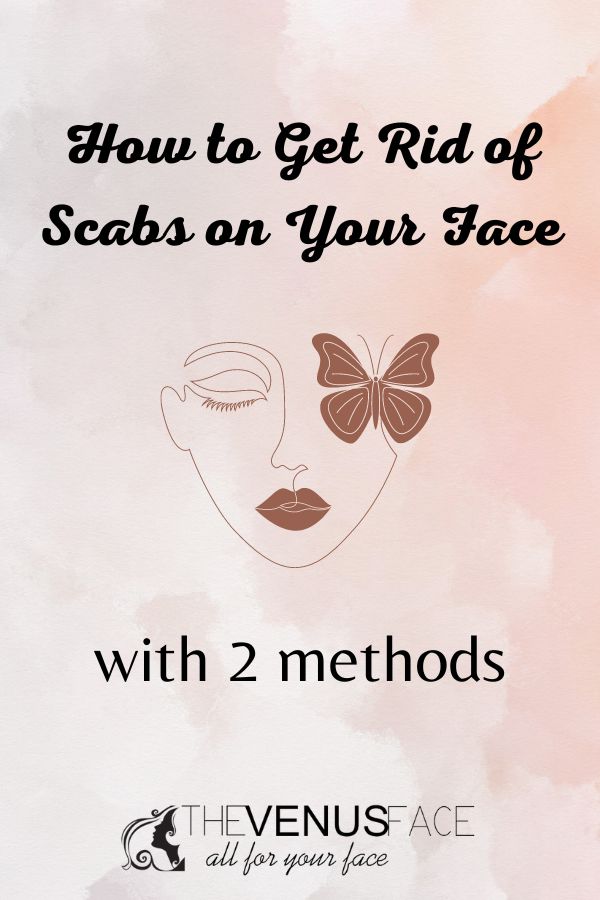Wanna learn how to get rid of scabs on the face? Read on!
When a scab forms over a wound, it is protecting the area beneath it as new skin cells grow and the wound heals. Scabs typically form within 24-48 hours after an injury and are usually at their worst around day 5-10. At this point, they may be large, uncomfortable, and itchy. Usually, scabs on faces are caused by acne, dry skin, cuts, or scrapes… Although scabs are good for healing, they can be unsightly and make you feel self-conscious. If you want to get rid of scabs on your face, there are basically 2 methods:
- Make the scabs heal fast
- Cover the scabs with makeup

How to heal a scab on your face fast?
There are a number of things you can do to speed up the healing process and get rid of scabs on your face quickly:
Keep it clean
Many people don’t realize that keeping your skin clean is crucial to helping wounds heal. That’s because when you have a cut or scrape, your body forms a protective barrier called a scab. Scabs keep infection-causing bacteria out and help new skin cells grow. But if you don’t clean the area around the wound, bacteria can get trapped under the scab and cause an infection. That’s why it’s important to practice good hygiene when you have a wound. Make sure to wash your hands thoroughly before and after caring for the wound. And avoid picking at or scratching the scab, as this can also lead to infection. Also, remember to use a mild cleanser to wash your face, including the area around the wound.
Moisturize it
Keeping your skin moisturized is another important step in the healing process. When your skin is dry, it’s more likely to crack and become infected. That’s why using a good moisturizer is essential, especially if you have a wound. Look for an ointment or cream that contains ingredients like petroleum jelly or vitamin E. These ingredients will help to keep your skin hydrated and promote healing. Apply the moisturizer to the wound several times a day, as needed. You should also apply it to the area around the wound to help prevent dryness and cracking.
Antibiotic ointment
If you have a deep or serious wound, your doctor may recommend using an antibiotic ointment. This type of ointment helps to prevent infection and promote healing. Apply the ointment to the wound as directed by your doctor. You should also apply it to the area around the wound. The most appropriate ointments should contain salicylic acid or benzoyl peroxide.
Cover it up
Once your wound is clean and dry, you’ll need to protect it from further harm. That’s why it’s important to cover the wound with a bandage or dressing. This will help to keep the area clean and prevent bacteria from getting in. It will also protect the wound from further injury. Be sure to change the bandage regularly, as needed. And if the dressing becomes wet or dirty, be sure to change it right away.
Sunscreen
If you have a wound that’s healing, it’s important to protect it from the sun. That’s because ultraviolet (UV) rays can delay healing and increase the risk of scarring. To protect the wound, apply sunscreen with an SPF of 30 or higher. Be sure to reapply it every two hours, or as directed by the manufacturer. And be sure to cover the wound with a bandage or dressing before going outside.
How to cover a scab with makeup?
In case you have a party to attend and don’t want your scab to be visible, you can cover it with makeup. Basically, covering a scab is like covering any other blemish on your skin. However, there is a bit of difference because we want to achieve both: good coverage and not irritate the wound.
Start with a clean base
Wash your face with a gentle cleanser and apply your usual moisturizer. Let it sink in for a few minutes before moving on to the next step. This will help your scabs blend in better with the rest of your skin and also maintain proper hygiene.
Apply primer (optional)
If you have a primer, apply it to your face now. This will help your makeup last longer and give you a flawless finish. If you don’t have a primer, that’s okay. You can still cover your scab without one.
Choose your foundation (and concealer)
When it comes to foundations, you want to find one that provides good coverage. A full-coverage foundation is usually best. You may also want to consider using a concealer in addition to your foundation. This will help to give you the coverage you need without being too heavy. So at this stage, there are 2 choices:
- Use a full coverage foundation alone: this option is simple and easy, but it is not for everyone, since some skin types, such as oily skin, can’t handle too much foundation without looking cakey; if you have good experience with full coverage foundation, go for it.
- Use a light/medium foundation along with a concealer: this option is more versatile and can be tailored to your specific needs. If you have oily skin, for example, use a light foundation and focus the concealer on the scab area only.
Apply other makeup as usual
At this stage, you can apply finishing powder, bronzer, contour, and any other makeup products you usually wear.
Final thoughts
A scab is a natural part of the healing process, but that doesn’t mean you have to show it off to the world. Now you know how to get rid of scabs on the face. By following the steps above, you can cover your scab with makeup and get on with your life. Just be sure to practice proper wound care so that your scab heals properly.


